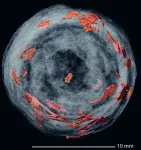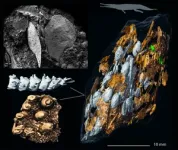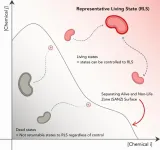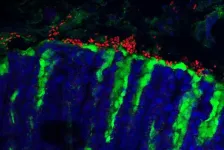(Press-News.org) ***Embargoed until November 27 at 11 AM EST***
Chronic diseases like type 2 diabetes and inflammatory disorders have a huge impact on humanity. They are a leading cause of disease burden and deaths around the globe, are physically and economically taxing, and the number of people with such diseases is growing.
Treating chronic disease has proven difficult because there is not one simple cause, like a single gene mutation, that a treatment could target. At least, that’s how it has appeared to scientists. However, research from Whitehead Institute Member Richard Young and colleagues, published in the journal Cell on November 27, reveals that many chronic diseases have a common denominator that could be driving their dysfunction: reduced protein mobility. What this means is that around half of all proteins active in cells slow their movement when cells are in a chronic disease state, reducing the proteins’ functions. The researchers’ findings suggest that protein mobility may be a linchpin for decreased cellular function in chronic disease, making it a promising therapeutic target.
In this paper, Young and colleagues in his lab, including postdoc Alessandra Dall’Agnese, graduate students Shannon Moreno and Ming Zheng, and research scientist Tong Ihn Lee, describe their discovery of this common mobility defect, which they call proteolethargy; explain what causes the defect and how it leads to dysfunction in cells; and propose a new therapeutic hypothesis for treating chronic diseases.
“I’m excited about what this work could mean for patients,” says Dall’Agnese. “My hope is that this will lead to a new class of drugs that restore protein mobility, which could help people with many different diseases that all have this mechanism as a common denominator.”
“This work was a collaborative, interdisciplinary effort that brought together biologists, physicists, chemists, computer scientists and physician-scientists,” Lee says. “Combining that expertise is a strength of the Young lab. Studying the problem from different viewpoints really helped us think about how this mechanism might work and how it could change our understanding of the pathology of chronic disease.”
Commuter delays cause work stoppages in the cell
How do proteins moving more slowly through a cell lead to widespread and significant cellular dysfunction? Dall’Agnese explains that every cell is like a tiny city, with proteins as the workers who keep everything running. Proteins have to commute in dense traffic in the cell, traveling from where they are created to where they work. The faster their commute, the more work they get done. Now, imagine a city that starts experiencing traffic jams along all the roads. Stores don’t open on time, groceries are stuck in transit, meetings are postponed. Essentially all operations in the city are slowed.
The slow down of operations in cells experiencing reduced protein mobility follows a similar progression. Normally, most proteins zip around the cell bumping into other molecules until they locate the molecule they work with or act on. The slower a protein moves, the fewer other molecules it will reach, and so the less likely it will be able to do its job. Young and colleagues found that such protein slow-downs lead to measurable reductions in the functional output of the proteins. When many proteins fail to get their jobs done in time, cells begin to experience a variety of problems—as they are known to do in chronic diseases.
Discovering the protein mobility problem
Young and colleagues first suspected that cells affected in chronic disease might have a protein mobility problem after observing changes in the behavior of the insulin receptor, a signaling protein that reacts to the presence of insulin and causes cells to take in sugar from blood. In people with diabetes, cells become less responsive to insulin — a state called insulin resistance — causing too much sugar to remain in the blood. In research published on insulin receptors in Nature Communications in 2022, Young and colleagues reported that insulin receptor mobility might be relevant to diabetes.
Knowing that many cellular functions are altered in diabetes, the researchers considered the possibility that altered protein mobility might somehow affect many proteins in cells. To test this hypothesis, they studied proteins involved in a broad range of cellular functions, including MED1, a protein involved in gene expression; HP1α, a protein involved in gene silencing; FIB1, a protein involved in production of ribosomes; and SRSF2, a protein involved in splicing of messenger RNA. They used single-molecule tracking and other methods to measure how each of those proteins moves in healthy cells and in cells in disease states. All but one of the proteins showed reduced mobility (about 20-35%) in the disease cells.
“I’m excited that we were able to transfer physics-based insight and methodology, which are commonly used to understand the single-molecule processes like gene transcription in normal cells, to a disease context and show that they can be used to uncover unexpected mechanisms of disease,” Zheng says. “This work shows how the random walk of proteins in cells is linked to disease pathology.”
Moreno concurs: “In school, we’re taught to consider changes in protein structure or DNA sequences when looking for causes of disease, but we’ve demonstrated that those are not the only contributing factors. If you only consider a static picture of a protein or a cell, you miss out on discovering these changes that only appear when molecules are in motion.”
Can’t commute across the cell, I’m all tied up right now
Next, the researchers needed to determine what was causing the proteins to slow down. They suspected that the defect had to do with an increase in cells of the level of reactive oxygen species (ROS), molecules that are highly prone to interfering with other molecules and their chemical reactions. Many types of chronic-disease-associated triggers, such as higher sugar or fat levels, certain toxins, and inflammatory signals, lead to an increase in ROS, also known as an increase in oxidative stress. The researchers measured the mobility of the proteins again, in cells that had high levels of ROS and were not otherwise in a disease state, and saw comparable mobility defects, suggesting that oxidative stress was to blame for the protein mobility defect.
The final part of the puzzle was why some, but not all, proteins slow down in the presence of ROS. SRSF2 was the only one of the proteins that was unaffected in the experiments, and it had one clear difference from the others: its surface did not contain any cysteines, an amino acid building block of many proteins. Cysteines are especially susceptible to interference from ROS because it will cause them to bond to other cysteines. When this bonding occurs between two protein molecules, it slows them down because the two proteins cannot move through the cell as quickly as either protein alone.
About half of the proteins in our cells contain surface cysteines, so this single protein mobility defect can impact many different cellular pathways. This makes sense when one considers the diversity of dysfunctions that appear in cells of people with chronic diseases: dysfunctions in cell signaling, metabolic processes, gene expression and gene silencing, and more. All of these processes rely on the efficient functioning of proteins—including the diverse proteins studied by the researchers. Young and colleagues performed several experiments to confirm that decreased protein mobility does in fact decrease a protein’s function. For example, they found that when an insulin receptor experiences decreased mobility, it acts less efficiently on IRS1, a molecule to which it usually adds a phosphate group.
From understanding a mechanism to treating a disease
Discovering that decreased protein mobility in the presence of oxidative stress could be driving many of the symptoms of chronic disease provides opportunities to develop therapies to rescue protein mobility. In the course of their experiments, the researchers treated cells with an antioxidant drug—something that reduces ROS—called N-acetyl cysteine and saw that this partially restored protein mobility.
The researchers are pursuing a variety of follow ups to this work, including the search for drugs that safely and efficiently reduce ROS and restore protein mobility. They developed an assay that can be used to screen drugs to see if they restore protein mobility by comparing each drug’s effect on a simple biomarker with surface cysteines to one without. They are also looking into other diseases that may involve protein mobility, and are exploring the role of reduced protein mobility in aging.
“The complex biology of chronic diseases has made it challenging to come up with effective therapeutic hypotheses,” says Young, who is also a professor of biology at the Massachusetts Institute of Technology. “The discovery that diverse disease-associated stimuli all induce a common feature, proteolethargy, and that this feature could contribute to much of the dysregulation that we see in chronic disease, is something that I hope will be a real game changer for developing drugs that work across the spectrum of chronic diseases.”
END
Cellular traffic congestion in chronic diseases suggests new therapeutic targets
2024-11-27
ELSE PRESS RELEASES FROM THIS DATE:
Cervical cancer mortality among US women younger than age 25
2024-11-27
About The Study: This study found a steep decline in cervical cancer mortality among U.S. women younger than 25 years between 2016 and 2021. This cohort of women is the first to be widely protected against cervical cancer by human papillomavirus (HPV) vaccines. The findings from this study in the context of other published research suggest that HPV vaccination affected the sequential decline in HPV infection prevalence, cervical cancer incidence, and cervical cancer mortality.
Corresponding ...
Fossil dung reveals clues to dinosaur success story
2024-11-27
In an international collaboration, researchers at Uppsala University have been able to identify undigested food remains, plants and prey in the fossilised faeces of dinosaurs. These analyses of hundreds of samples provide clues about the role dinosaurs played in the ecosystem around 200 million years ago. The findings have been published in the journal Nature.
“Piecing together ‘who ate whom’ in the past is true detective work,” says Martin Qvarnström, researcher at the Department of Organismal Biology and lead author of the study. “Being able to examine what animals ate and how they interacted with their environment helps us understand what enabled ...
New research points way to more reliable brain studies
2024-11-27
Brain-wide association studies, which use magnetic resonance imaging to identify relationships between brain structure or function and human behavior or health, have faced criticism for producing results that often cannot be replicated by other researchers.
A new study published in Nature demonstrates that careful attention to study design can substantially improve the reliability of this type of research. For the study, Kaidi Kang, a biostatistics PhD student, Simon Vandekar, PhD, associate professor of Biostatistics, and colleagues analyzed data from more than 77,000 brain scans across 63 studies.
The ...
‘Alzheimer’s in dish’ model shows promise for accelerating drug discovery
2024-11-27
A decade ago, researchers introduced a new model for studying Alzheimer’s disease. Known as “Alzheimer’s in a dish,” the model uses cultures of mature brain cells suspended in a gel to recapitulate what takes place in the human brain over 10 to 13 years in just six weeks. But does the model truly produce the same changes that take place in patients? In a new study, researchers from Mass General Brigham, in collaboration with colleagues at Beth Israel Deaconess Medical Center (BIDMC), created an algorithm to assess, in an unbiased manner, how well models of Alzheimer’s disease ...
Ultraprocessed food intake and psoriasis
2024-11-27
About The Study: The results of this study showed an association between high ultraprocessed food intake and active psoriasis status. After adjustments for age, body mass index (BMI), alcohol intake, and comorbidities, the results remained significant, suggesting that ultraprocessed food intake has a proinflammatory action separate from high BMI.
Corresponding Author: To contact the corresponding author, Emilie Sbidian, MD, PhD, email emilie.sbidian@aphp.fr.
To access the embargoed study: ...
Race and ethnicity, gender, and promotion of physicians in academic medicine
2024-11-27
About The Study: The findings of this study indicate that preferential promotion of white men within academic medicine continues to persist in the new millennium, with racially and ethnically diverse women experiencing greater underpromotion. To achieve a workforce that reflects the diversity of the U.S. population, this study suggests that academic medicine needs to transform its culture and practices surrounding faculty appointments and promotions.
Corresponding Author: To contact the corresponding author, Lauren Clark, MS, email lclark5@kumc.edu.
To access the embargoed study: ...
Testing and masking policies and hospital-onset respiratory viral infections
2024-11-27
About The Study: In this study, stopping universal masking and SARS-CoV-2 testing was associated with a significant increase in hospital-onset respiratory viral infections relative to community infections. Restarting the masking of health care workers was associated with a significant decrease.
Corresponding Author: To contact the corresponding author, Theodore R. Pak, MD, PhD, email tpak@mgh.harvard.edu.
To access the embargoed study: Visit our For The Media website at this link https://media.jamanetwork.com/
(doi:10.1001/jamanetworkopen.2024.48063)
Editor’s ...
A matter of life and death
2024-11-27
Cellular death is a fundamental concept in the biological sciences. Given its significance though, its definition depends on the context in which it takes place, and lacks a general mathematical definition. Researchers from the University of Tokyo propose a new mathematical definition of death based on whether a potentially dead cell can return to a predefined “representative state of living,” which are the states of being that we can confidently call “alive.” The researchers’ work could be useful for biological researchers and future medical research.
While it’s ...
Huge cost savings from more efficient use of CDK4/6 inhibitors in metastatic breast cancer reported in SONIA study
2024-11-27
On November 27, the prestigious journal Nature will publish the results of an innovative breast cancer research project from the Netherlands. This study, the SONIA trial, showed that delaying and shortening the duration of a specific anti-cancer therapy (CDK4/6 inhibitors) in patients with hormone receptor-positive advanced breast cancer leads to similar survival outcomes, while reducing toxicity and achieving substantial cost reductions: over 45 million euros per year in the Netherlands and over 5 billion dollars in the United States. This is the first time an efficiency study like this has been conducted in collaboration with Dutch health ...
What a gut fungus reveals about symbiosis and allergy
2024-11-27
A fungus discovered in the mouse stomach may hold a key to fungal evolution within the gastrointestinal tract, according to new research led by Weill Cornell Medicine investigators. The finding suggests that preclinical studies until now have overlooked a major influencer of mouse physiology.
Scientists recently have come to appreciate the importance, for human health and disease, of microbes—often called “commensals”—that naturally dwell in the gut. Bacterial commensals, for example, are known to have ...





